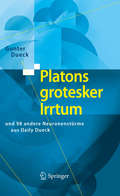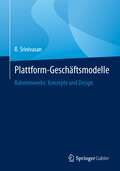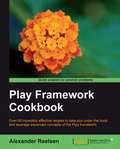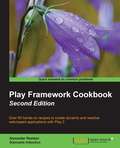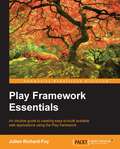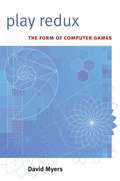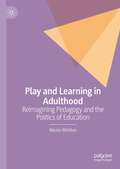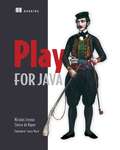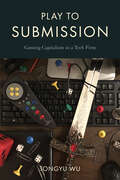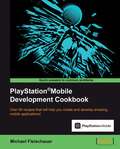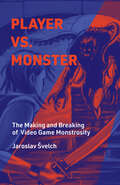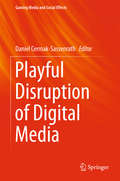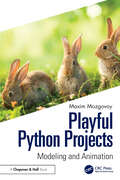- Table View
- List View
Platons grotesker Irrtum
by Gunter DueckSeit 2005 schreibt der Bestsellerautor Gunter Dueck auf seiner Hompepage www.omnisophie.com alle 14 Tage ein neues "Daily Dueck". Mehr als 5000 Stammleser finden dort Satirisches, Ergötzliches oder auch herb Kritisches. Der Band versammelt die ersten 99 "Daily Duecks" für diejenigen, die lieber ein Buch in den Händen halten möchten. Dueck warnte schon früh vor der Finanzkrise, er schreibt witzige oder ätzend scharfe Pointen über Heuschrecken, treudoofe Bestandskunden, Arbeitsstress und Werteverluste und wirbt für mehr Vertrauen im Arbeitsleben.
Plattform-Geschäftsmodelle: Rahmenwerke, Konzepte und Design
by R. SrinivasanDieses Buch stellt Plattformfirmen als einzigartige Geschäftsmodelle vor. Unter Rückgriff auf die frühe Literatur zur Netzwerkökonomie und zu Strategiekonzepten untersucht dieses Buch, wie sich Plattformunternehmen in der modernen Geschäftswelt entwickeln. Aus einer strategischen Perspektive heraus vermittelt dieses Buch dem Leser Kernkonzepte, Fallstudien und Rahmenwerke zur Analyse von Plattformunternehmen. Das Buch unterscheidet Plattformunternehmen von traditionellen Pipeline-Firmen; es untersucht das Engagement mit verschiedenen Akteuren, die Wertschöpfung und den Betrieb von Plattformen; es erläutert die Ressourcen und Fähigkeiten von Plattformunternehmen, die ihnen einen nachhaltigen Wettbewerbsvorteil verschaffen; es analysiert die Leistungshebel beim Betrieb von Plattformgeschäftsmodellen, einschließlich der Komplementarität mit anderen Geschäftsmodellen; und es erörtert die Nachhaltigkeit von Plattformgeschäftsmodellen, unter anderem angesichts regulatorischer und gesellschaftlicher Herausforderungen.Das Buch ist als Leitfaden für Unternehmer gedacht, die Plattformunternehmen gründen und betreiben, für Führungskräfte in großen Unternehmen, die ihre Ressourcen umwidmen, um die Netzwerkdynamik in ihren Unternehmen in Gang zu setzen, für Nachwuchsführungskräfte und für Fachleute, die für ihre beruflichen und persönlichen Bedürfnisse mit unzähligen Plattformunternehmen zusammenarbeiten. Dieses Buch soll Entscheidungsträgern ein Portfolio von Entscheidungen an die Hand geben, die sie treffen müssen, um eine Plattformfirma zu gründen, zu betreiben, aufrechtzuerhalten und aus ihr Wert zu schöpfen. Es ist auch für Fachleute aus der Politik nützlich, um die wirtschaftlichen und politischen Implikationen der Regulierung und Steuerung von Plattformen in einer postdigitalen Welt zu verstehen.
Play Framework Cookbook
by Alexander ReelsenThis book is in Packt's Cookbook series. A Packt Cookbook contains recipes for solutions to the most important problems you face when working with a topic. Inside the Cookbook you will find: A straightforward and easy to follow format, A selection of the most important tasks and problems, Carefully organized instructions for solving the problem efficiently, Clear explanations of what you did, Details for applying the solution to other situations. This is the ideal book for people who have already written a first application with the Play Framework or have just finished reading through the documenation. In other words - anyone who is ready to get to grips with Play! Having a basic knowledge of Java is good, as well as well as some web developer skills - HTML and JavaScript
Play Framework Cookbook - Second Edition
by Alexander Reelsen Giancarlo InductivoThis book is aimed at advanced developers who are looking to harness the power of Play 2.x. This book will also be useful for professionals looking to dive deeper into web development. Play 2 .x is an excellent framework to accelerate your learning of advanced topics.
Play Framework Essentials
by Julien Richard-FoyThis book targets Java and Scala developers who already have some experience in web development and who want to master Play framework quickly and efficiently. This book assumes you have a good level of knowledge and understanding of efficient Java and Scala code.
Play It Safe Online
by Phyllis CornwallIntroduces proper online safety for children, including cyberbullies, limiting personal information, and being responsible.
Play My Game: A Stark Ever After Novella (Stark Series #17)
by J. KennerNew York Times bestselling author J. Kenner continues her beloved Stark series with an emotionally charged Stark Ever After novella for Nikki and Damien Stark and the story of their first Valentine's Day as newlyweds. For fans of Fifty Shades of Grey, Sylvia Day, Meredith Wild and Jodi Ellen Malpas.Happy Ever After is just the beginning... I never imagined that anything could top our honeymoon, but life as Mrs Damien Stark is sweeter than any fantasy. We are forever bound by our love and our desire. His touch is my greatest treasure - and is purely mine alone. Yet no matter where we go, the ghosts of our pasts follow. We can't escape our secrets, or the people who desperately want to bring us down. Even on Valentine's Day, neither of us is safe. I'll do whatever it takes to protect Damien, to fulfill his every need. His kiss is my calling, his passion my truest bliss. The dangers we face, we now face together - and nothing can make me run. Includes a preview of Say My Name, the first novel in J. Kenner's Stark International series, and its hero Jackson Steele...Find out how it all began for Damien and Nikki in J. Kenner's hot and addictive bestselling Stark series: Release Me, Claim Me, Complete Me, Take Me, Have Me, Play My Game, Seduce Me and Unwrap Me.Don't miss J. Kenner's sizzling Most Wanted series of three enigmatic and powerful men, and the striking women who can bring them to their knees: Wanted, Heated and Ignited.
Play My Game: A Stark Ever After Novella (Stark Series #17)
by J. KennerNew York Times bestselling author J. Kenner continues her beloved Stark series with an emotionally charged Stark Ever After novella for Nikki and Damien Stark and the story of their first Valentine's Day as newlyweds. For fans of Fifty Shades of Grey, Sylvia Day, Meredith Wild and Jodi Ellen Malpas.Happy Ever After is just the beginning... I never imagined that anything could top our honeymoon, but life as Mrs Damien Stark is sweeter than any fantasy. We are forever bound by our love and our desire. His touch is my greatest treasure - and is purely mine alone. Yet no matter where we go, the ghosts of our pasts follow. We can't escape our secrets, or the people who desperately want to bring us down. Even on Valentine's Day, neither of us is safe. I'll do whatever it takes to protect Damien, to fulfill his every need. His kiss is my calling, his passion my truest bliss. The dangers we face, we now face together - and nothing can make me run. Includes a preview of Say My Name, the first novel in J. Kenner's Stark International series, and its hero Jackson Steele...Find out how it all began for Damien and Nikki in J. Kenner's hot and addictive bestselling Stark series: Release Me, Claim Me, Complete Me, Take Me, Have Me, Play My Game, Seduce Me and Unwrap Me.Don't miss J. Kenner's sizzling Most Wanted series of three enigmatic and powerful men, and the striking women who can bring them to their knees: Wanted, Heated and Ignited.(P)2015 Random House Audio
Play Nice: The Rise, Fall, and Future Of Blizzard Entertainment
by Jason SchreierA NEW YORK TIMES BESTSELLER AND AN NPR BEST BOOK OF 2024 From a New York Times bestselling author and investigative journalist comes The Social Network for the video game industry: a riveting examination of Blizzard Entertainment's rise and shocking downfall—"A fast paced thrill ride, perfect for anyone who has ever played a video game" (Ben Mezrich). For video game fans, the name Blizzard Entertainment was once synonymous with perfection. The renowned company behind classics like Diablo and World of Warcraft was known to celebrate the joy of gaming over all else. What was once two UCLA students' simple mission — to make games they wanted to play — launched an empire with thousands of employees, millions of fans, and billions of dollars. But when Blizzard cancelled a buzzy project in 2013, it gave Bobby Kotick, the infamous CEO of corporate parent Activision, the excuse he needed to start cracking down on Blizzard's proud autonomy. Activision began invading Blizzard from the inside. Glitchy products, PR disasters, mass layoffs, and a staggering lawsuit marred the company's reputation and led to its ultimate reckoning. Based on firsthand interviews with more than 300 current and former employees, Play Nice chronicles the creativity, frustration, beauty, and betrayal across the epic 33-year saga of Blizzard Entertainment, showing us what it really means to "bleed Blizzard blue." Full of colorful personalities and dramatic twists, this is the story of what happens when the ruthless pursuit of profit meets artistic idealism.
Play Redux: The Form of Computer Games
by David MyersA new look at digital gaming and the aesthetics of play
Play and Learning in Adulthood: Reimagining Pedagogy and the Politics of Education
by Nicola WhittonThis book provides a theoretical and philosophical examination of games, play and playfulness and their relationships to learning and wellbeing in adulthood. It draws on an interdisciplinary literature base (including game-based learning, game studies, education, psychology, and game design) to present a critical manifesto for playful learning in post-compulsory education and lifelong learning. While there is an established body of work in games and learning in adulthood, and a wide literature on the value of play in childhood, the wider potential of play in adulthood and playfulness is under-explored and still emergent. This book offers a comprehensive overview of play in adulthood, exploring the benefits and drawbacks, examining why play in adulthood is different from play in childhood, the role of play in culture, and making an argument for why it is important in our society that we embrace the principles of playfulness.
Play for Java
by Nicolas Leroux Sietse de KaperSummaryPlay for Java shows you how to build Java-based web applications using the Play 2 framework. The book starts by introducing Play through a comprehensive overview example. Then, you'll look at each facet of a typical Play application, both by exploring simple code snippets and by adding to a larger running example. Along the way, you'll contrast Play and JEE patterns and learn how a stateless web application can fit seamlessly in an enterprise environment.About the BookFor a Java developer, the Play web application framework is a breath of fresh air. With Play you get the power of Scala's strong type system and functional programming model, and a rock-solid Java API that makes it a snap to create stateless, event-driven, browser-based applications ready to deploy against your existing infrastructure.Play for Java teaches you to build Java-based web applications using Play 2. This book starts with an overview example and then explores each facet of a typical application by discussing simple snippets as they are added to a larger example. Along the way, you'll contrast Play and JEE patterns and learn how a stateless web application can fit seamlessly in an enterprise Java environment. You'll also learn how to develop asynchronous and reactive web applications.The book requires a background in Java. No knowledge of Play or of Scala is assumed.Purchase of the print book includes a free eBook in PDF, Kindle, and ePub formats from Manning Publications.What's InsideBuild Play 2 applications using JavaLeverage your JEE skillsWork in an asynchronous waySecure and test your Play applicationAbout the AuthorsNicolas Leroux is a core developer of the Play framework. Sietse de Kaper develops and deploys Java-based Play applications.Table of ContentsPART 1 INTRODUCTION AND FIRST STEPSAn introduction to PlayThe parts of an applicationA basic CRUD applicationPART 2 CORE FUNCTIONALITYAn enterprise app, Play-styleControllers—handling HTTP requestsHandling user inputModels and persistenceProducing output with view templatesPART 3 ADVANCED TOPICSAsynchronous dataSecurityModules and deploymentTesting your application
Play for Scala: Covers Play 2
by Peter Hilton Erik BakkerSummaryPlay for Scala shows you how to build Scala-based web applications using the Play 2 framework. This book starts by introducing Play through a comprehensive overview example. Then, you'll look at each facet of a typical Play application both by exploring simple code snippets and by adding to a larger running example. Along the way, you'll deepen your knowledge of Scala as a programming language and work with tools like Akka.About this BookPlay is a Scala web framework with built-in advantages: Scala's strong type system helps deliver bug-free code, and the Akka framework helps achieve hassle-free concurrency and peak performance. Play builds on the web's stateless nature for excellent scalability, and because it is event-based and nonblocking, you'll find it to be great for near real-time applications.Play for Scala teaches you to build Scala-based web applications using Play 2. It gets you going with a comprehensive overview example. It then explores each facet of a typical Play application by walking through sample code snippets and adding features to a running example. Along the way, you'll deepen your knowledge of Scala and learn to work with tools like Akka.Written for readers familiar with Scala and web-based application architectures. No knowledge of Play is assumed.Purchase of the print book includes a free eBook in PDF, Kindle, and ePub formats from Manning Publications.What's InsideIntro to Play 2Play's MVC structureMastering Scala templates and formsPersisting data and using web servicesUsing Play's advanced featuresAbout the AuthorsPeter Hiltonv, Erik Bakker, and Francisco Canedo, are engineers at Lunatech, a consultancy with Scala and Play expertise. They are contributors to the Play framework.Table of ContentsPART 1: GETTING STARTED Introduction to PlayYour first Play applicationPART 2: CORE FUNCTIONALITYDeconstructing Play application architectureDefining the application's HTTP interfaceStoring data—the persistence layerBuilding a user interface with view templatesValidating and processing input with the forms APIPART 3: ADVANCED CONCEPTSBuilding a single-page JavaScript application with JSONPlay and moreWeb services, iteratees, and WebSockets
Play like a Feminist. (Playful Thinking)
by Shira ChessAn important new voice provides a riveting look at why video games need feminism and why all of us should make space for more play in our lives."You play like a girl": it's meant to be an insult, accusing a player of subpar, un-fun playing. If you're a girl, and you grow up, do you "play like a woman"--whatever that means? In this provocative and enlightening book, Shira Chess urges us to play like feminists. Furthermore, she urges us to play video games like feminists. Playing like a feminist is empowering and disruptive; it exceeds the boundaries of gender yet still advocates for gender equality. Feminism need video games as much as video games need feminism.
Play to Submission: Gaming Capitalism in a Tech Firm
by Tongyu WuGames are often a fun perk of a tech company job, and employees can “play to win” in the competition to succeed. But in studying “Behemoth” (a pseudonym for a top American tech company), Tongyu Wu discovered that gaming work culture was far more insidious. Play to Submission shows how Behemoth’s games undermined and manipulated workers. They lost their work-life balance and the constant competition made labor organizing difficult. Nonetheless, many workers embraced management’s games as a chance to show off their “gamer” identities and create a workplace culture with privileged insiders and exiled outsiders, with female and migrant workers usually in the latter group. Moreover, Wu indicates this may be the future of work for high- and low-skilled and, creative workers in an environment where capitalists have heightened demands for technology and creativity. Drawing from 13 months of ethnographic work, Wu presents a persistent reality in which the company reaps the reward of surplus productivity, leaving employees themselves in a highly competitive and sometimes precarious work position.
PlayStation®Mobile Development Cookbook
by Michael FleischauerWritten as a series of engaging and practical recipes, this essential Cookbook has been meticulously designed and reviewed in order to provide you with the ultimate reference for PlayStation®Mobile development.If you've got some prior experience with C# and want to create awesome projects for the PlayStation®Vita and PlayStationTMCertified devices, then this book is for you.
Player vs. Monster: The Making and Breaking of Video Game Monstrosity (Playful Thinking)
by Jaroslav SvelchA study of the gruesome game characters we love to beat—and what they tell us about ourselves.Since the early days of video games, monsters have played pivotal roles as dangers to be avoided, level bosses to be defeated, or targets to be destroyed for extra points. But why is the figure of the monster so important in gaming, and how have video games come to shape our culture&’s conceptions of monstrosity? To answer these questions, Player vs. Monster explores the past half-century of monsters in games, from the dragons of early tabletop role-playing games and the pixelated aliens of Space Invaders to the malformed mutants of The Last of Us and the bizarre beasts of Bloodborne, and reveals the common threads among them.Covering examples from aliens to zombies, Jaroslav Švelch explores the art of monster design and traces its influences from mythology, visual arts, popular culture, and tabletop role-playing games. At the same time, he shows that video games follow the Cold War–era notion of clearly defined, calculable enemies, portraying monsters as figures that are irredeemably evil yet invariably vulnerable to defeat. He explains the appeal of such simplistic video game monsters, but also explores how the medium could evolve to present more nuanced depictions of monstrosity.
Player vs. Player #1: Ultimate Gaming Showdown (Player vs. Player #1)
by M.K. EnglandIn this action-packed illustrated series, four kid gamers meet at a virtual tournament and battle for the ultimate grand prize. Perfect for young fans of Ready Player One and Mr. Lemoncello's Library.Sixty-four teams.One mysterious grand prize.Four gamers determined to win it all. Welcome to Affinity, the hottest battle royale video game in the world! Gamers can be anything they want to be in Affinity&’s high-tech, magical universe—and test their skills in fierce PvP combat. So when Hurricane Games announces an epic tournament with killer prizes, four kids form a team that feels unstoppable . . . but also maybe doomed from the start? Josh is the tank . . . when his parents let him game.Hannah is the melee fighter . . . but she can only play at the public library.Larkin is the healer . . . as long as her family&’s not around.Wheatley is the ranger . . . with a secret that might wreck the whole team. As solo gamers, they&’re good. Really good. But the tournament is a whole new level of competition, and it'll take all four of them to bring it home. Can they step up their game in time for the final match?
Player vs. Player #2: Attack of the Bots (Player vs. Player #2)
by M.K. EnglandIn book 2 of this action-packed illustrated series, the best kid gamers return to the world of eSports and battle for glory at their first pro tournament. Perfect for young fans of Ready Player One and Mr. Lemoncello's Library.Welcome to Affinity, the hottest battle royale video game around! Since winning the first-ever Affinity tournament, The Weird Ones are supposed to be on top of the world. Josh, Hannah, Larkin, and Wheatley have formed their own professional team and launched a popular streaming channel, and they&’re set to take eSports by storm.But the kids have an awful secret: Wheatley is missing. And considering the threats he received before he disappeared, the other team members are worried. Plus, they keep getting matched with random players in-game who seem . . . disturbingly Wheatley-like? It&’s creepy. Sinister, even. And it&’s getting worse.With their first pro match looming, the kids are running out of time. They need help, and fast—because without Wheatley, their pro dreams may be dashed before the game even begins.
Player vs. Player #3: The Final Boss (Player vs. Player #3)
by M.K. EnglandIn the epic finale of this illustrated series, the best kid gamers in the world face their biggest battle yet, as they fight for their friend's freedom and all their gaming futures. Perfect for young fans of Ready Player One and Mr. Lemoncello's Library.Welcome to Affinity, the hottest battle royale video game around! The Weird Ones—Josh, Hannah, Larkin, and Wheatley—have become four of the biggest stars in gaming. But a surprising twist to their first professional Affinity tournament leaves Wheatley in huge trouble . . . with Hurricane Games, the company that made the game they all love.To save Wheatley, Hurricane offers them a deal: win three near-impossible challenges and Wheatley will be free. But if they lose, the kids will be banned from Affinity for life . . . and they&’ll never see Wheatley again.With their futures on the line, The Weird Ones will have to play the best they ever have. But is winning even possible when your opponent literally controls the game?
Players and Their Pets: Gaming Communities from Beta to Sunset
by Mia Consalvo Jason BegyIn the world of massively multiplayer online games (MMOGs), Faunasphere was but a blip on the screen in its short public life from 2009 to 2011. Its devoted players, many of them middle-aged women, entered a world that did not build on common fantasy or science-fiction tropes. There was no evil to defeat or realms to conquer, only friendly animals to care for and pollution to fight.In Players and Their Pets, Mia Consalvo and Jason Begy argue that its very difference makes it critically important—even more so than the large, commercially successful games such as World of Warcraft that have all too often shaped game studies discourse. Consalvo and Begy demonstrate how the beta period of an MMOG can establish social norms that guide how the game is played. They also show how a game&’s platform creates expectations for how the game will work and who is playing it—and what happens when those expectations clash with the reality. Even while telling the story of this particular game and its predominantly female players, however, Players and Their Pets cautions against oversimplifying players based on their gender. Faunasphere&’s playerbase enjoyed diverse aspects of the game, for varied reasons. No other game studies book tracks the entire life cycle of an online game to examine how the game evolved in terms of design as well as how its player community responded to changes and events. The brief life of Faunasphere makes this possible.
Playful Design
by John FerraraGame design is a sibling discipline to software and Web design, but they're siblings that grew up in different houses. They have much more in common than their perceived distinction typically suggests, and user experience practitioners can realize enormous benefit by exploiting the solutions that games have found to the real problems of design. This book will show you how.
Playful Disruption of Digital Media (Gaming Media and Social Effects Ser.)
by Daniel Cermak-SassenrathThis book starts with the proposition that digital media invite play and indeed need to be played by their everyday users. Play is probably one of the most visible and powerful ways to appropriate the digital world. The diverse, emerging practices of digital media appear to be essentially playful: Users are involved and active, produce form and content, spread, exchange and consume it, take risks, are conscious of their own goals and the possibilities of achieving them, are skilled and know how to acquire more skills. They share a perspective of can-do, a curiosity of what happens next? Play can be observed in social, economic, political, artistic, educational and criminal contexts and endeavours. It is employed as a (counter) strategy, for tacit or open resistance, as a method and productive practice, and something people do for fun.The book aims to define a particular contemporary attitude, a playful approach to media. It identifies some common ground and key principles in this novel terrain. Instead of looking at play and how it branches into different disciplines like business and education, the phenomenon of play in digital media is approached unconstrained by disciplinary boundaries. The contributions in this book provide a glimpse of a playful technological revolution that is a joyful celebration of possibilities that new media afford. This book is not a practical guide on how to hack a system or to pirate music, but provides critical insights into the unintended, artistic, fun, subversive, and sometimes dodgy applications of digital media.Contributions from Chris Crawford, Mathias Fuchs, Rilla Khaled, Sybille Lammes, Eva and Franco Mattes, Florian 'Floyd' Mueller, Michael Nitsche, Julian Oliver, and others cover and address topics such as reflective game design, identity and people's engagement in online media, conflicts and challenging opportunities for play, playing with cartographical interfaces, player-emergent production practices, the re-purposing of data, game creation as an educational approach, the ludification of society, the creation of meaning within and without play, the internalisation and subversion of roles through play, and the boundaries of play.
Playful Pedagogy in the Pandemic: Pivoting to Game-Based Learning (The COVID-19 Pandemic Series)
by Anastasia Salter Emily K. JohnsonEducational technology adoption is more widespread than ever in the wake of COVID-19, as corporations have commodified student engagement in makeshift packages marketed as gamification. This book seeks to create a space for playful learning in higher education, asserting the need for a pedagogy of care and engagement as well as collaboration with students to help us reimagine education outside of prescriptive educational technology. Virtual learning has turned the course management system into the classroom, and business platforms for streaming video have become awkward substitutions for lecture and discussion. Gaming, once heralded as a potential tool for rethinking our relationship with educational technology, is now inextricably linked in our collective understanding to challenges of misogyny, white supremacy, and the circulation of misinformation. The initial promise of games-based learning seems to linger only as gamification, a form of structuring that creates mechanisms and incentives but limits opportunity for play. As higher education teeters on the brink of unprecedented crisis, this book proclaims the urgent need to find a space for playful learning and to find new inspiration in the platforms and interventions of personal gaming, and in turn restructure the corporatized, surveilling classroom of a gamified world. Through an in-depth analysis of the challenges and opportunities presented by pandemic pedagogy, this book reveals the conditions that led to the widespread failure of adoption of games-based learning and offers a model of hope for a future driven by new tools and platforms for personal, experimental game-making as intellectual inquiry.
Playful Python Projects: Modeling and Animation
by Mozgovoy MaximThis book aims to take beginner and intermediate programming hobbyists to the next level by challenging them with exciting bite-size projects rooted in actual scientific and engineering problems.Each chapter introduces a set of simple techniques and shows a variety of situations where they can be applied. The main feature of the book is the choice of topics that are designed to be both entertaining and serious. Most of the projects strive to analyze or simulate something found in the real world, covering molecules and planets, plants and animals, bacteria and robots. Engaging in these excursions is a great way to hone coding skills while exploring diverse areas of human knowledge.The variety of discussed subjects and creative project ideas make the book a perfect choice for aspiring coders thinking where to apply their growing skills.
